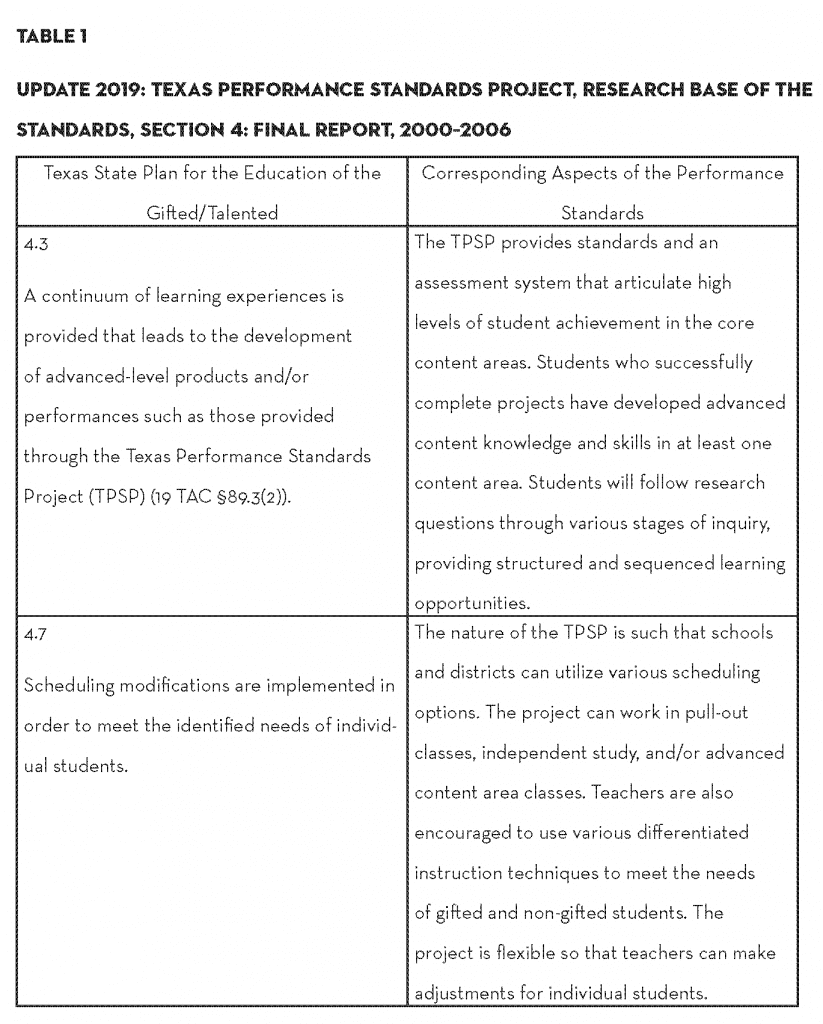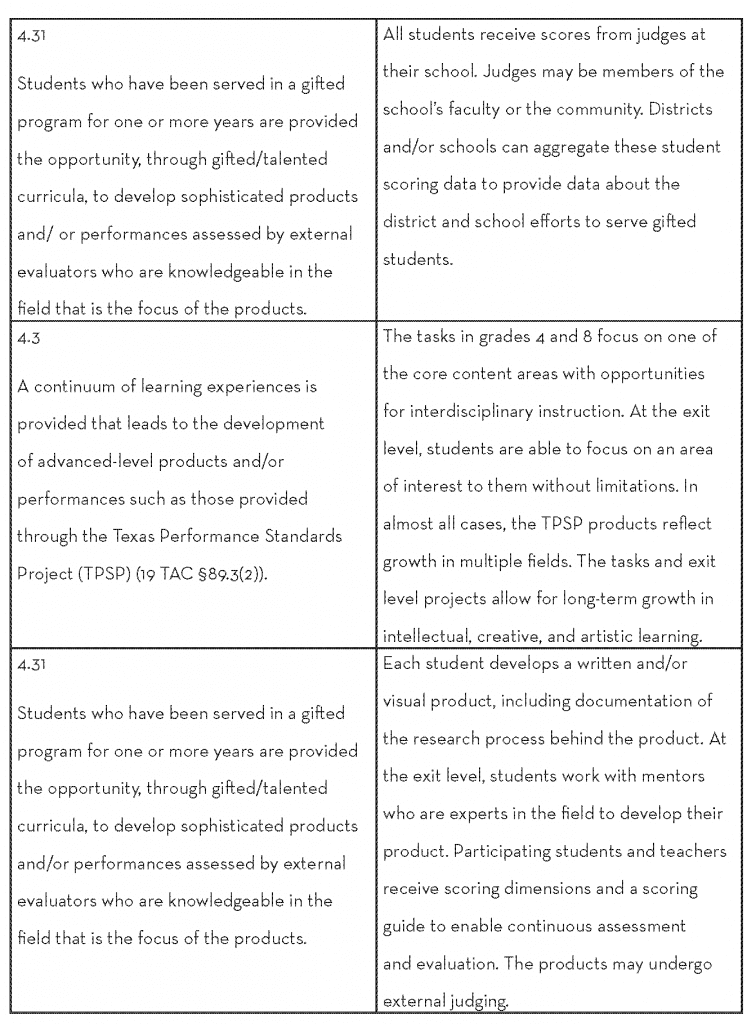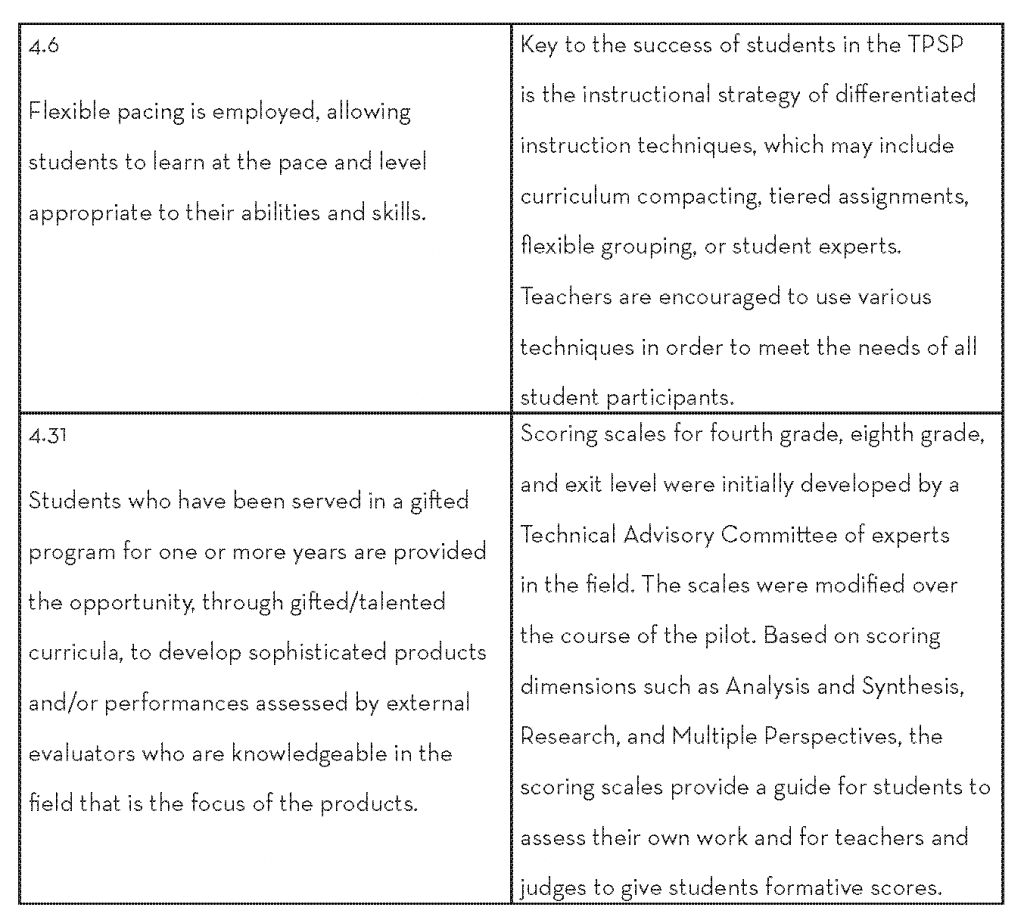Why Texas Performance Standards Project?
The Texas Education Agency’s (TEA) Advanced Academics provides guidance for the Texas Performance Standards Project (TPSP) through the TPSP website (https://www.texaspsp.org). This website offers a means to meet requirements found in the Texas State Plan for the Education of Gifted/Talented Students (State Plan; TEA, 2019) and instructs educators about TPSP in Section 4 Curriculum and Instruction:
4.3 A continuum of learning experiences is provided that leads to the development of advanced-level products and/or performances such as those provided through the Texas Performance Standards Project (TPSP) (19 TAC §89.3(2)). (p. 9)
For teachers and students who complete a TPSP project or a similar measure to determine growth of G/T students, TPSP provides more than just what to do: TPSP also offers the why and how to meet G/T students’ learning nature and needs.
The “Gifted/Talented Education Frequently Asked Questions” (https://tea.texas.gov/academics/special-student-populations/gifted-and-talented-education/gifted-talented-frequently-asked-questions) relating to TPSP address the why of TPSP:
Is participation in the Texas Performance Standards Project (TPSP) required?
No, school districts are not required to participate in the TPSP. Please note that the TPSP was developed in alignment with the State Goal for Services for Gifted/Talented Students and provides one option for schools to meet the requirements of the Texas State Plan for the Education of Gifted/Talented Students. TPSP is available for any Texas public school district or charter school to improve the rigor and relevance of its advanced academic instruction in Kindergarten to grade 12. For more information on TPSP, please visit http://www.texaspsp.org. (p. 2)
What spurred TEA to develop the Texas Performance Standards Project? Why did TEA Advanced Academics see TPSP as a means to evaluate the learning of gifted/talented students in our state?
History of the Texas Performance Standards Project
In the late 1990s, Advanced Academic Education had its own division under Curriculum and Instruction at the Texas Education Agency that included a director and a director of gifted education. Additionally, each of the 20 Education Service Centers (ESCs) were partially funded for a G/T specialist. During this time period, Evelyn Hiatt, Director of Advanced Academics, and Ann Wink, Director of Gifted Education at TEA, responded to the Texas Legislature’s request directing TEA to develop an assessment system and statewide standards for gifted/talented students.
Educators of the gifted and talented did not want a minimum standard as set in the No Child Left Behind Act to be applied to gifted learners as well. Action quickly was taken to move on the challenge of development. During this same time, Evelyn Hiatt was a member of a variety of national education boards, one of which was International Baccalaureate (IB). Based on IB’s in-depth curriculum research and its successful experiences in national and international education programs that had been in place for decades, the Advanced Academics team at TEA based the new Texas Performance Standards Project on IB’s final projects: Primary Years Programme Exhibition, Middle Years Programme Personal Project, and Diploma Programme’s Extended Essay.
A vertical alignment of skills, a state goal for services for the gifted/talented, and an outcome that included learning-product expectations was built with leadership from Hiatt and Wink, Dr. Ann Smisko, TEA division director and a constant supporter of all G/T efforts, and the representatives from the 20 ESCs under the leadership of B. K. Dean, Region 18 Education Service Center. Schools across the state were invited to participate in the pilot program for the institution of the initial Texas Performance Standards Project (see https://www.texaspsp.org/assets/uploads/docs/final_report.pdf).
In 1996, The Texas State Board of Education adopted the Texas State Plan for the Education of Gifted/Talented Students (State Plan). The State Plan outlines requirements that schools and districts must meet in order to ensure that gifted/talented students are being served. Many Texas schools and districts have struggled to find ways to differentiate curriculum for gifted/talented students, to provide a continuum of services for gifted/talented students across grade levels, and to assess their learning. To this end, The Texas Performance Standards Project created a way to meet the requirements of the State Plan through its set of standards and means of assessing the work of gifted/talented students with a system of challenging projects and independent research for fourth graders, eighth graders, and high school students. (Note. TPSP quickly expanded to all grade levels as seen on the website: http://www.texaspsps.org.)
With leadership from TEA, interested schools, and mandate from the Texas Legislature, Texas Performance Standards Project was born. G/T students and educators now have the what, how, and why of the Texas Performance Standards Project.
TPSP Website
The TPSP website (https://www.texaspsp.org) offers an array of informative guiding webpages and documents. These webpages and documents describe why TPSP is an important and necessary part of the gifted students’ curriculum. Those who framed this effort laid a foundation to accommodate the learning nature and needs of gifted students. As documented in the Resources page (https://www.texaspsp.org/resources), which shares the history, background, and formative research of the TPSP Final Report, this work was not created in a haphazard manner. Years of research and input from constituents ensure that students grow academically and emotionally as they access the treasures found in the Tasks Library and in expectations through evaluation tools.
All of the following are summaries of and quotes from sections found on the TPSP website.
Resources
Implementation Tools
This section offers insight for administrators on how to budget, how to schedule, and how to use and infuse TPSP into the classroom curriculum or for independent study. The Guides to Success add overviews of expectations and needs for each grade-level band. An administrative walkthrough form example is included for support as administrators observe TPSP in use.
Instructional Tools
This section of the Resources tab recommends instruction to teachers in curriculum compacting, tiered assignments, flexible grouping, and a Continuum of Learning Framework (COLEF), similar to a scope and sequence, for each grade-level span. The COLEF addresses research as well as depth and complexity.
Additional Resources
The TPSP Final Report is found in the Additional Resources section (https://www.texaspsp.org/resources/evaluation-reports) and includes the Executive Summary. If you are interested in more history of the Texas Performance Standards Project, the Final Report documents preserve that aspect of TPSP. Included in the Executive Summary document are the legislative background, research base, scoring dimensions, resources and materials (standards, assessment, and program evaluation), evaluation findings (objectives and activities), and key findings. The Final Report continues with an in-depth explanation of these topics, with recommendations and an appendix of protocols and forms used in the development of TPSP.
Included in the TPSP Final Report of the pilot projects is a chart with correlations to the Texas State Plan for the Education of Gifted/Talented Students, of the research base of the standards. Table 1 is an update of that chart by the authors.



Additional Resources also includes Promotional Materials, Evaluation Reports (from the TPSP Final Report), and a Glossary.
How to Use
This tab on the TPSP website (https://www.texaspsp.org/how-to-use) presents a comprehensive look at the Tasks, Grades K–10, Extended Research, Assessment, How Teachers Can Support Students Completing TPSP Projects, Research Skills, Organization and Time Management Support, and Documentation of Learning.
Tasks
Tasks are open-ended units of study. According to the website:
Tasks include a TEKS alignment guide, adaptable activities, and other resources. The structure and content of the tasks provide the following:
* Wide variety of choices for student learning
* Flexibility to pursue topics of student interest
* Real-life research experiences
* Focus on a high-quality product and presentation (TPSP, n.d., sec. 2)
Tasks are divided into grade spans of K–2, 3–5, 6–8 and 9–12. Many teachers experienced with TPSP say that students may explore Tasks out of their grade span to match areas of passion and interest. The Pursuit of Passion in each grade span “explores relationships between personal interests and future opportunities and how this relationship guides goal setting” (see https://www.texaspsp.org/tasks/pursuit-of-passion#englishOriginal).
Grades K–10
Grades K–10 organizes the Tasks into two phases to introduce skills and oversee guidance toward a product of students’ choosing. Phase I is led by the teacher. Phase II is the independent research section of the project. Although all Tasks include a presentation component with scoring guides, each particular Task has individual evaluations.
Extended Research and How Teachers Can Support Students Completing TPSP Projects
A strength of TPSP is that high school students may complete independent projects on topics of their choice, called Extended Research (see https://www.texaspsp.org/how-to-use). Students select their topic based on interests and passions that may or may not be connected to their regular curriculum. Selected projects are long term and meet the State Goal for Services for G/T Students which included the following:.
Students who participate in services designed for G/T students will demonstrate skills in self-directed learning, thinking, research, and communication as evidenced by the development of innovative products and performances that reflect individuality and creativity and are advanced in relation to students of similar age, experience, or environment. High school graduates who have participated in services for G/T students will have produced products and performances of professional quality as part of their program services. (p. 1)
In addition to meeting the requirement of professional quality, TPSP suggests that projects allow students to demonstrate sophisticated and advanced research methods and the use of technology appropriate to the field of study. Over the course of a year, each student works with a mentor who is a professional in the student’s field of study to create a unique, innovative final product or performance that is of professional quality. It is important that educators at all grade levels understand that the requirements of Extended Research are the goal for their gifted learners. Unless students have experience with projects starting in kindergarten, the interest in and time for an extended research project will be difficult for students.
The How to Use page of TPSP website also includes information about how teachers can support students with their projects, what research skills are needed, and how to do the actual research. Along with organization and time management support documents, ways to document student learning are included. The piece lacking is the current environment of online/distance learning that is a part of students’ days. In the last section of this article, strategies for completing TPSP projects during distance learning are shared.
Assessment
The Assessment section of the How to Use webpage defines the six domains of assessment that are applied to students’ projects. These are content knowledge and skills, analysis and synthesis, multiple perspectives, research, communication, and presentation of learning. Grades 9–12 add four more domains:
- ethics/unanswered questions,
- methodology and use of resources,
- relevance and significance, and
- professional quality.
Scoring dimensions are intended for sharing with students at the beginning of their Tasks or independent projects. When students have access to scoring, they self-evaluate and discuss the strengths and areas of need with their teacher or mentor. The TPSP (n.d.) site notes, “Upon completion of the project, the teacher scores the final product according to assessment rubric” (sec. 5, para. 3). Specific information about each area of the dimensions and rubrics are found on the How to Use TPSP webpage. Included with each are the research basis and references.
Tasks and Grade Bands
Each grade band on the Tasks webpage (https://www.texaspsp.org/tasks) covers the Tasks that are appropriate for that grade-level band, sample forms for organization, and assessments for that grade band. The grade band for grades 9–12 adds course credit options. The Subject Area tab looks at English language arts and reading, mathematics, science, and interdisciplinary studies. The 7E model can be applied to each Task. Texas Essential Knowledge and Skills (TEKS) for each grade level, as well as Texas College and Career Readiness Standards, are available. Tasks are in English and Spanish and may be sorted by grade level, alphabetically, or relevance. This portion of the TPSP website along with the actual Tasks provide a wealth of information for the daily work of students and allow opportunities to meet their learning nature, needs, and passions.
How to Use TPSP in a Virtual World
Paulina van Eeden Hill (2020), executive director of the Texas Association for the Gifted and Talented, queried Mike Morath, Commissioner of Education for TEA, who responded to her “Questions for Serving G/T Students in 2020–2021 School Year” with the following regarding remote learning plans, “In what section of the remote learning plan should districts include their remote learning plans for G/T services?” Morath’s response was, “The phrase ‘students with additional learning needs’ includes gifted/talented students.” From this statement, districts know that gifted/talented students are included in efforts similar to those in special services, English as a second language (ESL), 504, and other special designations.
In addition to this query, Morath responded to another of van Eeden Hill’s (2020) questions:
Will curriculum and lessons provided by Texas Home Learning 3.0 include G/T education strategies such as depth and complexity and higher order questions? Also, will the Texas Performance Standards Project and access to more challenging curriculum be easily accessible in this resource as an option for serving gifted students?
In response, Morath cited two instances in which the gifted must be included in Texas Home Learning. He first said, “Yes, Texas Home Learning 3.0 will include G/T strategies and supports. The Texas Performance Standards Project will be linking to THL 3.0 as an optional resource to meet the State Plan standards.” He continued, “THL 3.0 will make available all high-quality instructional material for teachers of the gifted to adapt to the unique needs of their learners.”
Monica Brewer, statewide coordinator for gifted/talented education at TEA, provides an Implementation Series available on the TEA gifted/talented webpage (https://tea.texas.gov/academics/special-student-populations/gifted-and-talented-education/gifted-talented-education-resources). The “Virtual TPSP Showcase Supporting Students at Home” presentation on May 5, 2020, cites the sections of the State Plan that address TPSP as noted in Table 1.
In the presentation, student showcase criteria, showcase panel volunteer expectations, student confidentiality, and logistics are offered to districts in preparation for a virtual TPSP showcase of final products (Slides 14–17; TEA, 2020). This PowerPoint presentation also includes scoring dimensions, activity focus, developing and implementing a research plan, presentation of learning, and proficiency descriptors (Slides 18, 20, and 21) as defined on the TPSP website.
Individual districts have approached distance learning with their G/T students in a variety of ways that adhere to local plans and requirements. At giftED20, Andi McNair (2020) and other educators offered a variety of sources that provide students with templates and online ways of developing products:
- Flipgrid
- Digital/physical newsletters
- SlidesMania
- Unsplash
- Padlet
- Bulb Digital Portfolio
Any of these may be a part of weekly or daily meeting to check with students and parents about their progress with their research and projects. Along with presentations from McNair and others at giftED20, TAGT Connect offers advice about how to meet the challenges gifted educators face in delivery of curriculum for our gifted/talented students. Reach out to other teachers and coordinators across the state who face similar challenges through TAGT Connect, Education Service Center gifted education specialists, and/or Monica Brewer at TEA.
A Final Word
Whether in-house or through virtual learning, outcomes for learning, presentations, and products are based on the State Goal for Services for Gifted/Talented Students:
Students who participate in services designed for gifted/talented students will demonstrate skills in self-directed learning, thinking, research, and communication as evidenced by the development of innovative products and performances that reflect individuality and creativity and are advanced in relation to students of similar age, experience, or environment. High school graduates who have participated in services for gifted/talented students will have produced products and performances of professional quality as part of their program services. (as cited in TEA, 2019, p. 1)
With the State Goal and TPSP in mind, gifted educators often ask their students, “So what if you know XYZ about a subject? In what ways does this knowledge enhance what you already know? How does it make you a different person? How does it make an impact on those around you, in your community, or, perhaps, the world?”
So, what if Texas educators of the gifted/talented access TPSP? In what ways does TPSP answer the same questions we ask of our students? The history of its inception gives insight into the “so what.”
This Texas effort is in line with project-based learning and with product-based learning, which frequently is used across the nation in progressive schools. At its essence, the State Goal encourages student agency and building internal capacity.
Although the objective of TPSP is for students to follow interests and develop their research passions in order to share insights and products, two areas—student agency and building internal capacity—are positive byproducts. My next TEMPO+ article will explore both student agency and building internal capacity.
References
McNair, A. (2020). Remote learning experience: Obstacle or opportunity [PowerPoint Slides] Presentation at giftED20, Texas Association for Gifted and Talented.
Region XIII Education Service Center. (2007). Texas Performance Standards Project pilot 2000–2006: Final report. https://www.texaspsp.org/assets/uploads/docs/final_report.pdf
Texas Education Agency. (2012). Gifted/talented education frequently asked questions. https://tea.texas.gov/sites/default/files/GT_FAQ_02-2012.pdf
Texas Education Agency. (2019). Texas state plan for the education of gifted/talented students. https://tea.texas.gov/Academics/Special_Student_Populations/Gifted_and_Talented_Education/Gifted_Talented_Education
Texas Education Agency. (2020, May 5). Virtual TPSP showcase supporting students at home. https://tea.texas.gov/academics/special-student-populations/gifted-and-talented-education/gifted-talented-education-resources
Texas Education Agency. (2020, October 15). Gifted/Talented education. https://tea.texas.gov/sites/default/files/covid/SY-20-21-GT-Guidance.pdf
Texas Performance Standards Project. (n.d.). How to use TPSP. https://www.texaspsp.org/how-to-use
van Eeden-Hill, P. (2020, August 24). Personal communication.







